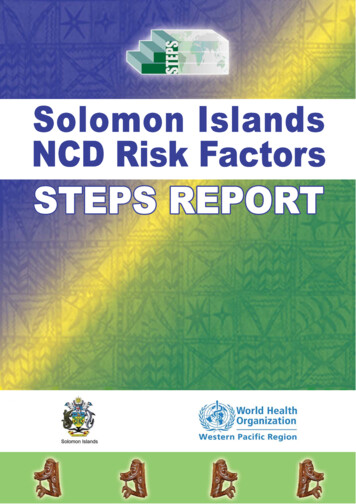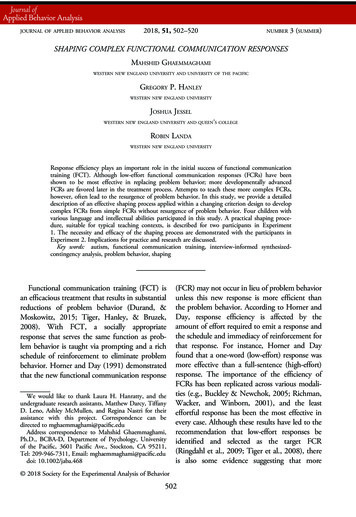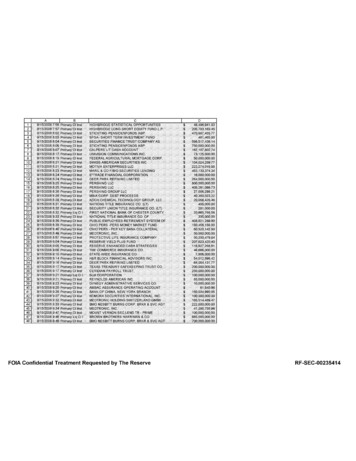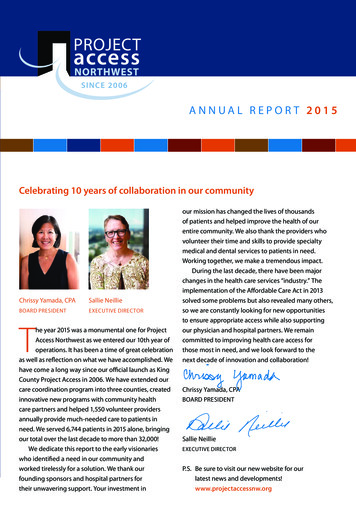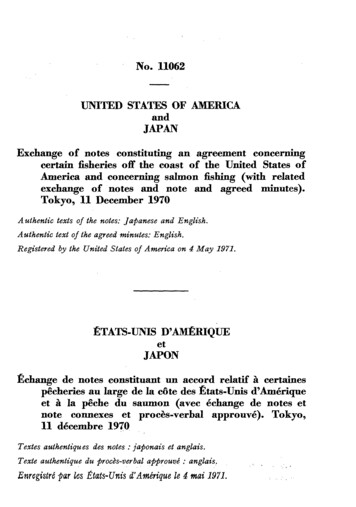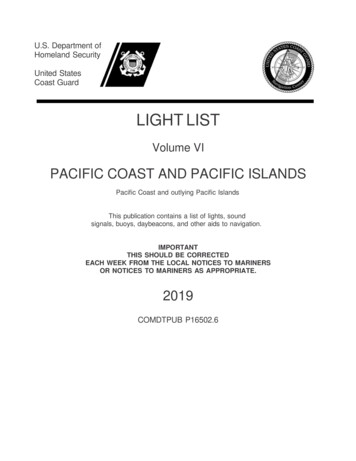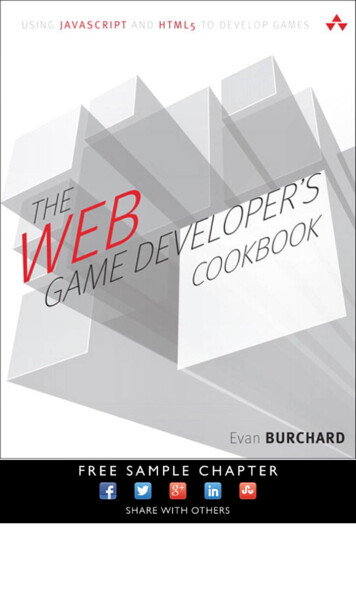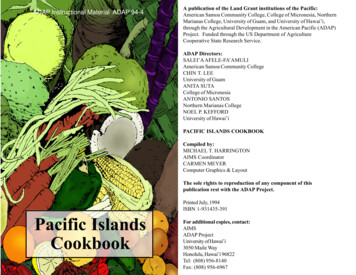
Transcription
ADAP Instructional Material ADAP 94-4A publication of the Land Grant institutions of the Pacific:American Samoa Community College, College of Micronesia, NorthernMarianas College, University of Guam, and University of Hawai’i,through the Agricultural Development in the American Pacific (ADAP)Project. Funded through the US Department of AgricultureCooperative State Research Service.ADAP Directors:SALEI’A AFELE-FA’AMULIAmerican Samoa Community CollegeCHIN T. LEEUniversity of GuamANITA SUTACollege of MicronesiaANTONIO SANTOSNorthern Marianas CollegeNOEL P. KEFFORDUniversity of Hawai’iPACIFIC ISLANDS COOKBOOKCompiled by:MICHAEL T. HARRINGTONAIMS CoordinatorCARMEN MEYERComputer Graphics & LayoutThe sole rights to reproduction of any component of thispublication rest with the ADAP Project.Printed July, 1994ISBN 1-931435-391Pacific IslandsCookbookFor additional copies, contact:AIMSADAP ProjectUniversity of Hawai’i3050 Maile WayHonolulu, Hawai’i 96822Tel: (808) 956-8140Fax: (808) 956-6967
Pacific IslandsCookbookAIMS Nutrition Work Team ParticipantsSalei’a Afele-Fa’amuliAmerican Samoa Community CollegeAnsina KonyCollege of MicronesiaFloria JamesNorthern Marianas CollegeLoreto MalimbanUniversity of GuamRebbeca PobocikUniversity of GuamNaomi KanehiroUniversity of Hawai’iResource PersonsPatricia BrittenJoda DerricksonLisa MillerRachel NovotnyAnne ShovicUniversity of Hawai’iThe ADAP Project is an equal opportunity employer. All servicesand information are available to anyone without regard to race, color,religion, sex, age, or national origin.
1Table of ContentsThe Importance of Local Foods. 1Estimated Nutritional Values. 2Eating Within the Food Guide Pyramid. 4Coconut. 6Green Leaves & 74Taro.86Yam.102Sweet Potato.110Cassava.120Fish & Meat.128The Importance of Local FoodsThis cookbook has been compiled from recipes used in the Pacificislands, for the purpose of promoting the use of local foods. The importanceand value of local foods can be addressed from many different perspectives.It is our hope that this cookbook can play a role in maintaining and developing cultural strengths, economic self-sufficiency, and healthy populations inthe region.Local or ethnic foods, like language, are corner-stones of culture andidentity. As the world becomes a global village many foods and recipes areshared and mixed between different places and groups. In many of thefarthest reaches of the Pacific region, packaged foods have gone from highlyprized commodities (canned beef) to everyday ingredients. Yet whetherliving at home, in Auckland, Los Angeles, or Tokyo; most islanders wouldidentify their traditional staples and local dishes as an important part of anyfamily gathering, holiday or ceremony.The cultural values of food are not just related to eating familiaritems, but also knowing where and how they were produced. Better yet is tohave grown the produce, raised the livestock, and prepared the foods withmembers of your family and community. Although modern life has drawnmany Pacific islanders from rural, agricultural work to cities and desk jobs,there is still a strong need for a connection to the land.From an economic standpoint, producing at least a portion of onesown food is a critical component of self-sufficiency for individuals andnations. Farmers and small food processors provide local employment andkeep the cash flow close to home. There are also factors of food security (aconstant supply) and safety, knowing what goes into the production andprocessing of available foods.Finally, local foods and traditional diets are not fads. They haveevolved within the environment where they are found. Pacific islanders havemaintained healthy lives in these places for thousands of years. However,contemporary lifestyles, with their new foods and work patterns have beenaccompanied by increases in diabetes, obesity, high blood pressure and/orheart disease. There is a clear need to identify recipes and their nutrientanalyses as a means to reverse this trend.
23Estimated Nutritional Values1. What do the “Estimated Nutritional Values” tables tell me aboutthese recipes?The tables that follow most recipes in this cookbook are designed to helpyou see how each one fits into an overall daily diet. It can help youdetermine the nutritional value of one serving in a recipe, or compare onerecipe with another. You can use it to decide how large a portion to eat orhow often to eat a type of food. The nutritional values provide importantinformation because what you eat can actually raise or lower your risk ofcertain nutrition related diseases.Nutritional values when you eat more than one serving:If you eat one serving, the “Estimated Nutritional Values” are easy tointerpret. What happens if you eat more than one serving? Here are someideas to help you. Let’s use the Laulau recipe from page 150 as an example.Estimated Nutritional ValuesAmount/Serving3. The “Estimated Nutritional Values” are based on 2,000 calories aday. If I eat more or less than that, how can these tables help me?Of course, not everyone eats this amount daily; some eat more, some less.Whatever your daily calorie intake, you can still use the % Daily Valuesas a reference to help you see how a particular food fits into the contextof a total daily diet. Further, the rule of thumb that 5% Daily Valuemeans a food is low in a nutrient is reasonable whether you eat 1,400calories per day or 2,500 calories per day.Tips for using “Estimated Nutritional Values” tablesThink about your reasons for using this information.Are you concerned about limiting fat or sodium in your diet? Do you want toincrease the amount of iron or calcium? You may want to pick out only oneor two things to look at in the table. Focus on what is most important to you.Check the number of servings per recipe.The number of calories and the nutrient amounts are based on one servingfrom the whole recipe. Check to see if you eat more or less.Amount/Serving% DV*Calories244 kcal12 %Carbohydrate10 Gm3 %Total Fat11 Gm17 %Iron4.1 Mg23 %3 Gm15 %Calcium173 Mg17 %74 Mg25 %Vitamin A7366 IUSodium256 Mg11 %Vitamin C79.3 Mg 132 %Protein29 Gm58 %Saturated Fat2. How can I use these tables quickly and easily?The “Estimated Nutritional Values” contain a new reference tool calledthe % Daily Value that tells you whether a food is high or low in anutrient like fat, sodium or cholesterol. A simple rule of thumb to followis that if the % Daily Value is 5% or less for a nutrient, that food is low inthat nutrient. Since all the nutrients are on the same scale, this rule holdsfor fat, sodium, vitamin C, iron, and all other nutrients. The goal is tochoose foods that together give you no more than 100% of fat, sodium,and cholesterol and at least 100% of nutrients such as iron and calcium.% DV*Cholesterol147 %*Percent daily Values (DV) are based on a 2,000 calorie dietServings in this recipe:6(1 serving 1 Laulau)How do you use the information if you eat two Laulau’s?First: Find the number of calories for each serving and multiply that bythe number of servings you plan to eat (2 laulau’s 2 servings)Second: Now do the same thing for the remaining nutrients. Take fat forexample. There are 11 grams of fat per laulau and you will eat two:1.2.244 calories per serving x 2 laulau’s 488 calories11 grams of fat x 2 laulau’s 22 grams of fat.What if you plan to eat half of the recipe?First: You need to find out how many calories are in the whole recipe.Multiply the number of calories in one serving by the total numberof servings in the recipe:Second: Now multiply the total calories by the amount that you eat1/3 the recipe is the same as .50 of the recipe1/4 the recipe is the same as .25 of the recipe3/41.2.the recipe is the same as .75 of the recipe244 Kcal/serving x 6 servings in the whole recipe 1464 Kcal1464 calories x .50 732 caloriesYou can use the same calculations for any of the remaining nutrients.
45Eating within the Food Guide PyramidThe Food Guide Pyramid has been developed to help you see how to eatbetter every day. Eating a variety of foods is an important idea for goodnutrition. However, there are some types of food that are recommended inlarger or smaller amounts than others.A pyramid shape is much larger at the bottom and smaller at the top.The Food Guide Pyramid shows foods at the bottom which should be eatenin proportionately larger amounts than those above. Stay healthy by eatingmore grains, starches, fruits and vegetables and fewer foods from the toplevels.The small tip of the Pyramid shows fats, salt, and sugars. These arefoods such as; coconut cream, butter, mayonnaise, soy sauce, soft drinks, andcandies. Alcoholic beverages are also a part of this group. These foodsprovide calories but few other nutrients.Each recipe in this cookbook which contains an “Estimated NutritionalValues” table also provides information about the number of food pyramidservings. The information looks like this:Milk: 0Veg:1Fruit:0Bread:2.Food Guide FoodsFruitsMeat: 0.5In this example, from the recipe for Chicken with Long Rice on page156, the measured portion of the recipe in the analysis is equal to one servingof vegetable, two servings of bread, and one-half serving of meat.Grain Foods and Starchy VegetablesHow many servings do you need each day?The recommended number of servings from each food group for children,active women and most men are as follows:Bread group:Vegetable group:Fruit group:Milk group:Meat group:9 servings4 servings3 servings2 servings2 servingsThese numbers are different for other people such as; older adults, teen boys,and active men.For more information on nutrition, diet analysis, or useof the food guide pyramid, contact your local EFNEPagent. EFNEP is the Expanded Food & NutritionEducation Program, available at each Land Grantinstitution in the American Pacific region.
67CoconutThe coconut plant, Cocos nucifera, is a tree in the palm family. Thereare many varieties within the species. Dwarf varieties grow to about 14 feetand flower in three years after planting. Tall varieties grow to 70 or 80 feetand flower in about eight years. They have a long productive life and requirelittle care once established.Coconut palms have been called the “Tree of Life” in Pacific islandsbecause all parts of the plant are useful in many daily activities. In addition tothe food uses of the coconut meat, it is also pressed for oil to use on the bodyand to make soaps. The hard shell around the meat can be used as a cup, orpolished and carved into buttons, combs and other articles. The husks of thenut are used for scrubbing and the fibers woven into rope. Coconut leaves arewoven into baskets, hats and a variety of useful items. The midribs of theleaves are stripped out and bundled to form a broom. The wood of thecoconut tree trunk is very hard and can be cut for lumber or paneling.The tree bears coconuts all year around. It takes about a year afterflowering for nuts to mature and fall to the ground. Green drinking nuts arepicked at about seven months old, just before the meat inside begins toharden.The “water” inside of a fresh unripe coconut is a refreshing andhealthy drink. It can be a sweet and flavorful substitute for commercial softdrinks. In emergencies doctors have even used it as an intraveneuos solutionfor replacing body fluids and minerals.As this cookbook demonstrates, coconut cream is a part of manyPacific island recipes. It is produced by squeezing the grated coconut meatmixed with water. As a standard measure, two grated coconuts and one cupof water will yield one cup of coconut cream. A thinner product, coconutmilk, is made by the same process using two cups of water.The “Estimated Nutritional Values” tables in this section show that useof coconut cream and coconut milk in recipes is a concern for maintaining ahealthy diet. Both of these foods are extremely high in saturated fat. In mostrecipes using these foods, a note has been added that substituting up to half ofthe coconut cream with cow’s milk will reduce the saturated fat. Cannedcondensed milk is thicker, like coconut cream. An extract of coconut can beadded for flavoring.It is understood that Pacific islanders have used coconut cream as animportant part of their diet for a very long time. However, changes haveoccurred in many people’s lifestyles in the region. Work has become moresedentary and other forms of exercise may have decreased. The increased useof prepared foods in the diet has also introduced additional sources of fat andsaturated fat. The issue is complex with many variables to consider. Yet, thecurrent nutritional recommendations which limit fat and saturated fat in thediet would suggest that the use of coconut cream in recipes should be limitedto a few occasions and in small quantities.
89Coconut CreamCoconut WaterEstimated Nutritional ValuesEstimated Nutritional ValuesAmount/ServingCalories% DV*40 %% DV*Carbohydrate16 Gm5 %Total FatSaturated Fat83 Gm 128 %74 Gm 370 %IronCalcium5.5 Mg26 Mg31 %3 %CholesterolSodium0 Mg10 Mg0 %0 %Vitamin AVitamin C0 IU6.7 Mg0 %11 %9 Gm18 %Protein792 kcalAmount/ServingAmount/ServingCaloriesTotal FatSaturated FatCholesterolSodiumProtein% DV*Amount/Serving% DV*46 kcal1 Gm2 %2 %CarbohydrateIron9 Gm0.7 Mg3 %4 %1 Gm0 Mg5 %0 %CalciumVitamin A58 Mg0 IU6 %0 %252 Mg2 Gm11 %4 %Vitamin C5.7 Mg10 %*Percent daily Values (DV) are based on a 2,000 calorie diet*Percent daily Values (DV) are based on a 2,000 calorie dietNutritional Values are based on 1 cup of coconut creamNutritional Values are based on 1 cup of coconut waterCoconut MilkEstimated Nutritional ValuesAmount/ServingCaloriesTotal Fat% DV*552 kcal57 Gm28 %88 %Amount/Serving% DV*CarbohydrateIron13 Gm3.9 Mg4 %22 %Saturated FatCholesterol51 Gm 255 %0 Mg0 %CalciumVitamin A38 Mg0 IU4 %0 %SodiumProtein36 Mg6 GmVitamin C6.7 Mg11 %2 %12 %*Percent daily Values (DV) are based on a 2,000 calorie dietNutritional Values are based on 1 cup of coconut milk
1011Green Leaves & VegetablesGreen leaves are an important source of vitamins and minerals inPacific Island diets. Some kinds of green leaves grow on trees or bushes, andothers on smaller leafy plants. Many plants that are raised for other purposeshave leaves that can be eaten, for example, taro, cassava, and pumpkin.Luau leaves or lau kalo (taro leaves) are an excellent source ofvitamin C and vitamin A, and a fair source of iron. They also containcalcium, much of which is in the form of calcium oxylate crystals that preventthe body from absorbing it unless the leaves are cooked first. The crystalscan make your throat itchy if not cooked long enough. Never eat the rawleaves. Handle leaves while they are dry if possible. Wet leaves will causehands to itch.Sweet Potato leaves, Ipomoea batatas, are easy to grow and a goodsource of vitamin A and fiber. They are the above ground portion of an edibleroot crop.Watercress, Nasturtium officinale, is a trailing plant that grows infresh, moving water. It can be eaten raw or cooked, and is a good source ofboth vitamin A and vitamin C.Chinese cabbage, is a popular garden plant with many varieties suchas Pak Choy, Ung Choy, or Saladeer. It is grown in a small seedbed and thentransplanted to the garden area, where it reaches maturity in about one month.Pele or Sunset Hibiscus, Hibiscus manihot, is a small woody shrubwith leaves that are tasty and high in protein. They are also high in vitaminA and vitamin C. It is very easy to grow from branches which are cut andstuck into wet soil.Seaweeds are the green leaves of the sea. There are different ediblevarieties that are popular with Pacific Islanders. Some are green with tinybubbles along their stems. Others are dark greenish-brown with long softstrands joined together. They are easily collected when the tide is low.Pumpkin is a plant with both fruit and leaves that are high in vitamins.To cook the tips of the vines, scrape or peel off the hairy skin first. Pumpkinplants grow easily from either seeds or cuttings with roots.
1312PalusamiTaro Leaves201121/2young taro leavesonioncup coconut creamteaspoons salt191/2Boil taro leaves in a small amount of water for 30 minutes, then pouroff the water. Add coconut cream to the taro leaves. Add salt and onion andmix them together. Cook taro leaves for another 30 minutes, until done andall itchiness is removed.Note: Very high in saturated fat. To reduce, replace up to half ofcoconut cream with whole or low fat milk.cup onion, finely choppedcup coconut creamtaro leavesteaspoon saltUse only young, fresh taro leaves or substitute spinach leaves. Putabout 6 halves of taro leaves on top of each other in the palm of your lefthand (if you are right-handed). Cup left hand and with fingers of right hand,press down in center so that the leaves form a cup. Then ladle in about 1/2cup of the coconut mixture. Fold together leaves at the top of the cup tomore or less seal in the liquid, then seal into a cupped piece of foil. Bake at350ºF for about 1/2 an hour. When cool, remove foil and serve with taro,breadfruit, or any starchy food.Floria P. James/NMC/EFNEPNote: Extremely high in saturated fat. To reduce, replace up to half ofcoconut cream with whole or low fat milk.Estimated Nutritional ValuesASCC/EFNEPAmount/Serving% DV*Amount/Serving% DV*Estimated Nutritional ValuesCaloriesTotal FatSaturated FatCholesterolSodiumProtein119 kcal11 Gm6 %17 %CarbohydrateIron6 Gm1.5 Mg2 %8 %9 Gm0 Mg45 %0 %CalciumVitamin A67 Mg2967 IU7 %59 %536 Mg0 Gm22 %0 %Vitamin C26.5 Mg44 %Milk: 0Veg:10Bread:0Meat:0% DV*304 kcal28 GmSodiumProtein8Fruit:CaloriesTotal FatSaturated FatCholesterol*Percent daily Values (DV) are based on a 2,000 calorie dietServings in this recipe:Amount/ServingAmount/Serving15 %43 %CarbohydrateIron25 Gm 125 %0 Mg0 %361 Mg7 Gm15 %14 %% DV*12 Gm3.8 Mg4 %21 %CalciumVitamin A16.0 Mg2115 IU2 %42 %Vitamin C35 Mg58 %*Percent daily Values (DV) are based on a 2,000 calorie dietServings in this recipe:Milk: 0Veg:13Fruit:0Bread:0Meat:0
1415Gollai Hagon SuniLuau Leaves and Boiled Butter Fish(Taro Leaf with Vegetables)624111/2111111/224cups watertaro leavescup thin coconut milkcups coconut creamlarge tomato, choppedtablespoon grated fresh yellow gingerclove garlic, choppedmedium onion, slicedlime or lemon (3 to 4 tablespoons juice)teaspoon salt1/4Wash the taro leaves thoroughly, remove stems. Place in small amountof boiling water. Partially cover the pot and allow the luau leaves to simmerfor 1 hour. Taro leaves are done when tender.Wash and scale butterfish. Place in water and boil for 15 minutes.Drain, add fresh water and boil again until tender, 10–15 minutes.Drain and debone fish. Combine with taro leaves and serve.Roll up one dozen taro leaves at a time and chop into 1/2 inch slices.Put leaves into 6 cups boiling water. Boil about 1 hour or until leaves aremushy. Drain taro leaves. Add thin coconut milk, lemon or lime juice,ginger, garlic, onion, and tomato to taro leaves. Salt to taste. Boil togetherfor 6 minutes. Add coconut cream, boil for 3 minutes. Remove from stoveand serve with rice.Note: Extremely high in saturated fat. To reduce, replace up to half ofcoconut cream with whole or low fat milk.UOG/GCE/EFNEP% DV*UH/CTAHR/EFNEPEstimated Nutritional ValuesAmount/ServingCaloriesTotal Fat238 kcal23 GmAmount/ServingSaturated FatCholesterolSodiumProtein12 %35 %CarbohydrateIron20 Gm 100 %0 Mg0 %143 Mg4 Gm6 %8 %% DV*9 Gm2.3 Mg3 %13 %CalciumVitamin A48 Mg1623 IU5 %32 %Vitamin C22 Mg37 %*Percent daily Values (DV) are based on a 2,000 calorie dietServings in this recipe:Milk: 0Veg:0.58Fruit:0Bread:0Amount/Serving% DV*110 kcal4 Gm6 %6 %CarbohydrateIronSaturated FatCholesterol0 Gm13 Mg0 %5 %CalciumVitamin A1 Mg0 %7650 IU 153 %Protein15 Gm30 %Vitamin C111 Mg 185 %Servings in this recipe:Milk: 0CaloriesTotal Fat% DV*14 Gm6.7 Mg5 %37 %*Percent daily Values (DV) are based on a 2,000 calorie dietEstimated Nutritional ValuesAmount/Servingbunches luau leaves (80 leaves)cups boiling waterlb. salted butterfishMeat:0Veg:36Fruit:0Bread:0Meat:0.5
1617Lu Pulu1121/21/21/2Taro Leaf and Chicken Soupbanana leafyoung taro leaves12 oz. can of corned beefchopped onioncup thick coconut creamSpread out banana leaf. Overlap taro leaves on top of banana leaf.Place the corned beef in the center of the leaves. Add chopped onion. (Achopped tomato is good also.) Hold taro leaves together so a cup is formed.Pour in coconut cream. Close the taro leaves around the meat mixture. Foldbanana leaf around the taro leaves. This is “lu”. Tie a banana leaf rib aroundthe lu to hold it together. Boil or bake for 1 hour.Variation: Lu may be made with 1/2 lb. of any type of meat; beef,fish, lamb, or chicken.Note: Extremely high in saturated fat. To reduce, replace up to half ofcoconut cream with whole or low fat milk.21221812161tablespoons vegetable oilMaui onion, slicedgarlic cloves, mincedtablespoons ginger roottablespoon Hawaiian saltcups chicken stocktaro leaves, deveinedoz. chicken meat cut in stripsteaspoon black pepperIn a one-gallon soup pot, saute the onion, garlic and ginger in thevegetable oil until golden brown. Add the chicken stock and bring to a boil.Chop the taro leaves into bite size pieces and add to the boiling stock.Simmer for 25 minutes. Add the chicken meat, salt and pepper, cook another10 minutes and serve.Maui Prince Hotel/Island Fresh HawaiiEstimated Nutritional ValuesFrom Breadfruit Bread and Papaya Pie, Collected by Nancy RodyAmount/Serving% DV*Amount/Serving% DV*Estimated Nutritional ValuesAmount/ServingCaloriesTotal FatSaturated FatCholesterolSodiumProtein% DV*Amount/Serving% DV*324 kcal16 %Carbohydrate11 Gm4 %23 Gm16 Gm35 %80 %IronCalcium4.7 Mg21 Mg26 %2 %49 Mg577 Gm16 %24 %Vitamin AVitamin C2820 IU44.5 Mg56 %74 %23 Gm46 %CaloriesTotal FatSaturated FatCholesterolSodiumProtein200 kcal12 Gm10 %18 %CarbohydrateIron4 Gm2.2 Mg1 %12 %3 Gm45 Mg15 %15 %CalciumVitamin A26 Mg1470 IU3 %29 %1616 Gm21 Gm67 %42 %Vitamin C16.5 Mg28 %*Percent daily Values (DV) are based on a 2,000 calorie dietServings in this recipe:8*Percent daily Values (DV) are based on a 2,000 calorie dietMilk: 0Servings in this recipe:Milk: at:1
1918Sweet Potato Tops Salad (Pohnpei)Taro and Chicken122231122chicken or 43/4 cups chopped boneless chickenmedium sized tarolarge onions choppedcups chopped green leaves (taro leaves, pumpkin tips, pele)tomatoescup coconut creamcup watertablespoons lemon juice1/221/41/4Blanch potato tops by dipping in boiling water. Chop, then mix withthe rest of the ingredients. Chill and serve.Peel taros, cut them into thin slices, and place the cut-up taro in thebottom of a large saucepan. Cut the chicken into serving portions and placeon top of the taro. Add the chopped onions, green leaves, and tomatoes.Sprinkle lemon juice. Add the coconut cream and water, and cook over agentle heat for about 11/2 hours, or until the chicken is cooked.Note: High in saturated fat. To reduce, replace up to half of coconutcream with whole or low fat milk.Amount/Serving% DV*Amount/Serving% DV*350 kcal18 %Carbohydrate18 Gm6 %Total FatSaturated Fat21 Gm12 Gm32 %60 %IronCalcium2.3 Mg28 Mg13 %3 %CholesterolSodium66 Mg67 Gm22 %3 %Vitamin AVitamin C930 IU17.4 Mg19 %29 %Protein23 Gm46 %*Percent daily Values (DV) are based on a 2,000 calorie dietServings in this recipe:Veg:From Breadfruit Bread and Papaya Pie, Collected by Nancy RodyEstimated Nutritional ValuesAmount/ServingSaturated FatCholesterolEstimated Nutritional ValuesMilk: 0Note: Very high in sodium. To reduce, use less soy sauce.CaloriesTotal FatASCC/EFNEPCalorieslbs. sweet potato topscup lemon juiceteaspoons saltcup soy saucecup mayonnaise18Fruit:0Bread:0.5Meat:1SodiumProtein% DV*Amount/Serving160 kcal9 Gm8 %14 %CarbohydrateIron1 Gm6 Mg5 %2 %CalciumVitamin A1755 Gm8 Gm73 %16 %Vitamin C% DV*16 Gm3.2 Mg5 %18 %79 Mg8 %16245 IU 325 %31.2 Mg52 %*Percent daily Values (DV) are based on a 2,000 calorie dietServings in this recipe:Milk: 0Veg:2.55Fruit:0Bread:0Meat:0
2021Camote SaladMinali Namul(Sweet Potato Salad-kangong)2211/21/21111/21lbs sweet potato leaveslarge tomatoes, sliced thinsmall round onion, sliced thinteaspoon saltteaspoon patis, optionalteaspoon chopped ginger, optional1/41113Pick tender leaves and stems. Rinse thoroughly. With some water stillon the leaves, put in sauce pan and heat. Toss leaves in hot pan to blanchevenly. Add remaining ingredients. Toss lightly but thoroughly.Note: Patis is not included in the analysis below. Eating largeamounts of salt and patis can contribute to high blood pressure and heartdisease. Go easy on adding them in cooking.1/8bunch watercress (1 pound)cups boiling waterteaspoon sesame oilteaspoon sugarclove garlic, mincedcarrot, gratedteaspoon sesame seedstablespoons soy sauceteaspoon cayenne pepper or finely chopped red pepper, optionalWash watercress. Remove undesirable leaves and tough stems. Cutinto 1-inch lengths.Cook in 11/2 cups boiling water for 3 minutes. Drain thoroughly. Addremaining ingredients, mix well, chill and serve.UH/CTAHR/EFNEPUH/CTAHR/EFNEPEstimated Nutritional ValuesEstimated Nutritional ValuesAmount/ServingAmount/Serving% DV*Amount/ServingCaloriesCaloriesTotal FatSaturated FatCholesterolSodiumProtein105 kcal5 %Carbohydrate20 Gm7 %1 Gm0 Gm2 %0 %IronCalcium2.7 Mg93 Mg15 %9 %0 Mg292 Gm0 %12 %10 Gm20 %Vitamin AVitamin C% DV*Amount/Serving% DV*% DV*20440 IU 409 %38 Mg 63 %Total FatSaturated FatCholesterolSodiumProtein30 kcal2 %Carbohydrate1 Gm0 Gm2 %0 %IronCalcium0 Mg550 Gm0 %23 %2 Gm4 %Vitamin AVitamin C3 Gm1 %0.5 Mg101 Mg3 %10 %3475 IU33.8 Mg70 %56 %*Percent daily Values (DV) are based on a 2,000 calorie diet*Percent daily Values (DV) are based on a 2,000 calorie dietServings in this recipe:Servings in this recipe:Milk: 0Milk: eat:0
2223Green Leaves Soup111/211/211261/2Eggs with Pele Leavesbundle Chinese cabbagecup thinly sliced meat or fishteaspoon corn flourteaspoon soy sauceteaspoon sugartablespoon vegetable oilonion, choppedteaspoons sliced gingercups waterteaspoon saltpepper to taste4211/21Put oil in fry pan. Warm it up before frying patties. Beat the eggs in abowl. Chop the pele leaves and put them inside the mixture. Add breadcrumbs, salt, pepper, and onions to the mixture. Shape into patties and fry.Combine soy sauce, sugar, and corn flour, mix well. Add meat or fishand set aside. Heat oil, add ginger, onion and fry until tender. Boil water inlarge pot. Add meat or fish, soy sauce mixture, ginger and onion. Simmer 10minutes. Add green leaves and simmer for another 10 minutes. Season withsalt or pepper.ASCC/EFNEPAmount/ServingSaturated FatCholesterolSodiumProtein% DV*Amount/Serving102 kcal4 Gm5 %6 %CarbohydrateIron1 Gm16 Mg5 %5 %176 Gm24 Gm7 %24 %Servings in this recipe:Veg:ASCC/EFNEPEstimated Nutritional ValuesCalories% DV*4 Gm1.2 Mg1 %7 %CalciumVitamin A8 Mg1270 IU1 %25 %Vitamin C33 Mg55 95 kcal25 %Carbohydrate26 Gm5 Gm40 %25 %IronCalcium426 Mg 142 %540 Gm 23 %Protein0 GmVitamin AVitamin C% DV*43 Gm14 %4.9 Mg176 Mg27 %18 %2830 IU18.3 Mg57 %31 %0 %*Percent daily Values (DV) are based on a 2,000 calorie dietMilk: 06Fruit:Total FatSaturated Fat% DV*Servings in this recipe:*Percent daily Values (DV) are based on a 2,000 calorie dietMilk: 0Note: Very high in cholesterol due to eggs in recipe. To reduce, useegg substitute.Amount/ServingEstimated Nutritional ValuesCaloriesTotal Fateggscups chopped pele leavescup bread crumbscup chopped oniontablespoon margarine or vegetable oilblack pepperVeg:12Fruit:0Bread:0.5Meat:0.5
2524Faiai LimuPilikaki and Pele Leaves(Seaweed)1101/211/4can pilikaki (pilchard or other canned fish)pele leaves cut in bite size (or 2 cups)cup chopped oniontablespoon vegetable oilteaspoon saltsoy sauce (optional)411/21/41Remove liquid in can of fish. Put oil in hot pan. Add onion to slightlybrown. Add canned fish. Stir a bit to avoid sticking for 2 minutes and tobreak fish into pieces. Add soy sauce if desired. Add pele. (Do not let peleleaves sit in water. Rinse slightly and quickly in running water beforechopping). Stir for another 2 minutes before serving with local staple of taro,breadfruit, cooked banana or rice.Note: Can substitute watercress in place of Pele leaves. Thissubstitution will lower the vitamin A values.cups limu (any variety except the green grape-like seaweed)cup coconut milk cupchopped onionteaspoon salt12-18" banana leafThe limu does not need rinsing in tap water. However, it must bethoroughly rinsed in seawater before removal from the ocean. It does notneed chopping either since it will dissolve in the cooking process.Pass the banana leaf over heat to soften it. It must not have holes in it,nor the hard rib attachment. Place limu in the center of the leaf. With
This cookbook has been compiled from recipes used in the Pacific islands, for the purpose of promoting the use of local foods. The importance and value of local foods can be addressed from many different perspectives.


